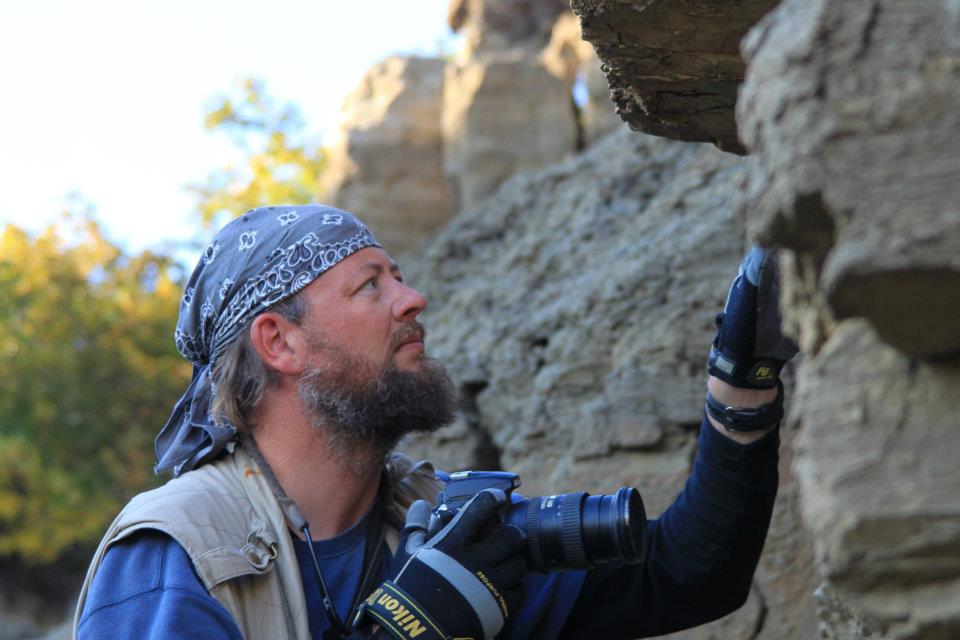Some information may be outdated.
Over 65 million years ago, a seaway existed across North America from the present-day Gulf of Mexico to present-day Alaska. Peter Flaig is a research scientist at the Bureau of Economic Geology in Austin, Texas, and has studied the geology of this seaway by looking at deposits from the southwest U.S. into Canada and Alaska. We talked with Flaig about the margin of this seaway that included parts of the present-day Colorado Plateau.
Science Moab: Can you speak a bit about the Western Interior Seaway, the prehistoric ocean across Western North America?
Flaig: [The Western Interior Seaway was] a seaway that cut through the continent and then ultimately disappeared. It was hundreds of meters deep, but not but not as deep as the continental shelf-slope-deepwater system. There were sediments that were coming off of the Sevier Orogeny. The Sevier Orogenic Belt buckled the lithosphere and created this big interior basin along the continent which filled up with water. Into this Interior Seaway, river and floodplain deposits enter as deltas and shorelines along this pretty complex coastline that ran all across North America. The Seaway divided Laramidia from Appalachia. [Laramidia was a landmass that stretched from modern-day Alaska to Mexico. -ed.]
Science Moab: How did the shoreline and water level of the Seaway change over time?
Flaig: You’d have tens to hundreds of meters of sea level fluctuation. The shorelines moved towards the center as the Seaway shrank and then backed up as the seaway rose, creating a lot of different depositional environments stacked one on top of another. You might start out with a very wide Seaway in one location with deltas, beaches and even offshore deposits. As the Seaway shrinks, those shorelines move to the east [and in that location] coastal plains form over the top of those ancient shores, so now you have trees in peat swamps and river systems and dinosaurs that lived on those coastal plains. As the Seaway again expanded, [that location would again] return to more marine conditions.
Science Moab: The Mancos Shale represents one of the deepest parts of the basin, is that correct?
Flaig: Think of the Mississippi Delta: if you were to walk on the actual sub-aerial part of the delta and start walking out into the Gulf of Mexico, the furthest delta front. Eventually, you would be in hundreds of meters of water where you’d lose all coarse grained sediments, like sands. You’re just depositing silts and muds. The Mancos Shale is that deeper part of the system, where you are past all of the real coarse grain sediment input and you’re just depositing those very fine silts and muds. That’s a large part of the basin, and it records an awful lot of time.
Science Moab: Is there any economic value to the Seaway’s deposits?
Flaig: The oil and gas industry is very interested in the deposits of the Seaway, because the outcrops are amazing. When folks drill oil and gas reservoirs, they have a Swiss-cheese view of what’s going on in the subsurface. These wells might be widely spaced and it’s very expensive to drill core. The Book Cliffs can provide us with outcrop analogs for these subsurface reservoirs. It’s not that they are necessarily reservoirs; they can be, but they represent what we can’t see in the subsurface. What might be a good reservoir and how connected it is over long distances, the Book Cliffs provide us with that continuous exposure.
Science Moab: What first made you want to study the Seaway?
Flaig: Well, the Bureau of Economic Geology was looking for someone to go out and take a look at these outcrops as analogs for reservoir systems. One of the best places to do that is in the Book Cliffs, so I initially started just using these as outcrop analogs for reservoirs for people all around the world. Then I became very interested in the deposits of the Seaway with respect to the kind of plants and animals they preserve, what they can tell us about the evolution of the interior of North America, and the natural things that happened to this planet based on waxing and waning of glaciers. What does that look like when humans aren’t around? We want to understand if we’re doing something with the planet and causing sea levels to rise or temperatures to change.
Science Moab: What are you passionate about studying with regards to the Seaway?
Flaig: I’m really interested in what what’s going on with the deposits. It’s very interesting to look at deposits to figure out why they have the characteristics that they do. The characteristics of these systems then speak to their broader geometries in the subsurface, where the shales are. For example, in Alaska, a lot of these systems dip into the subsurface and there are very active oil and gas reservoirs. I’m really interested in looking at the outcrops of these systems and understanding how these characteristics change, then predict if we are going to see the same things in the subsurface and ask if we should change our predictions about what’s actually happening.
Science Moab is a nonprofit dedicated to engaging community members and visitors with the science happening in Southeast Utah and the Colorado Plateau. To learn more and listen to the rest of this interview, visit www.sciencemoab.org/radio. This interview has been edited for clarity.
This page was edited on 10/11/2022 to correct terminology.
Appreciate the coverage? Help keep local news alive.
Chip in to support the Moab Sun News.





